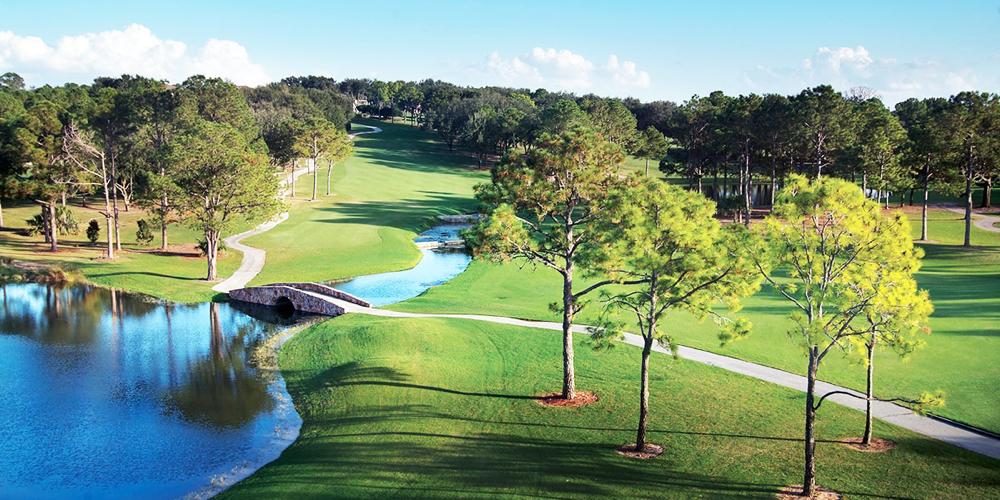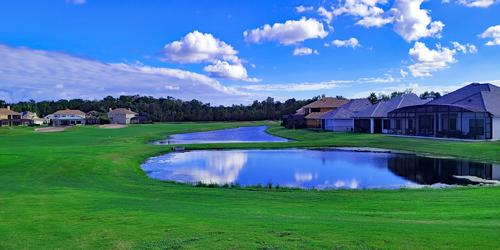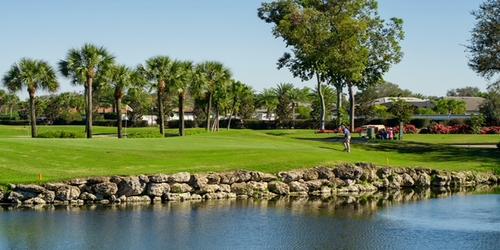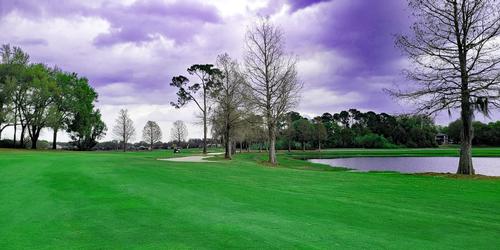
Mission Inn Golf Resort - El Campeon
By David Theoret
The Mission Inn Resort and Club is located about 35 miles northwest of Orlando in Howey-in-the Hills a town named for its founder, William John Howey. Howey was a real estate mogul and came to the area in the 1910s and bought up land for the purpose of developing citrus groves. During the Florida land boom, his investments skyrocketed and people began flocking to the area, naming the town after him. These days, Howey-in-the-Hills remains a peaceful village, just outside the shadows of Orlando's urban sprawl and attractions.
Originally dubbed the Floridian Country Club, the property was purchased by the Beucher family in 1964. Since the resort already had a Spanish flavor and feel to it, they decided to go with two Spanish named for the golf courses: El Campeon and Las Colinas.
The Resort itself is somewhat unique for the area, Spanish Colonial architecture furnished with luxurious amenities, offering travelers a choice of accommodations ranging from deluxe hotel rooms and suites to two and three-bedroom villas with kitchens. All rooms are non-smoking and feature either tennis or water views, screened balconies, high speed Internet access and well-appointed bathrooms with marble and granite. A covered walkway connects all three of Mission Inn's three inns to the property's restaurants, courtyards and meeting rooms.
Mission Inn is also popular among the tennis crowd and offers private lessons, tennis schools and match arranging. The Spa Marbella and four restaurants can also be found on the property.
Golf - El Campeon
Mission Inn Resort and Club is home to two tremendous 18-hole facilities - El Campeon and Los Colinas. El Campeon was designed by George O'Neil and built in 1917; it's one of the South's oldest golf courses. In 1926, Charles E. Clarke of Troon, Scotland redesigned the course and added a number of enhancements, including lengthening the layout to the 7.001 yards it still play to these days.
It is definitely not your typical Florida course. Hills and rolling fairways bring into play elevation changes of 85 feet or more. Elevated tee boxes and elevated greens having you hitting downhill, uphill and everything in between. Water comes into play on 13 holes and the greens are great. Just the right amount of undulation and speed.
Memorable Holes
Number 1: Par 5, 467 yards. The woods on the right can come into play if you hit anything that way off the tee. This starting hole is a fairly straight forward par 5. There is a small strand of pine trees in the fairway that you'll need to contend with off the tee. Your approach shot is to a fairly flat green with trouble right in the form of water.
Number 2: Par 3, 181 yards. This fairly lengthy par 3 is particularly challenging when playing into the wind. Bunkers dot the landscape surrounding the green which has a few subtle undulations. Par is a good score here.
Number 3: Par 4, 433 yards. This is a very challenging dogleg left par 4 that requires an accurate tee shot if you want to shoot a low score. It's a narrow driving hole that requires you to steer clear of the right side if you want tp take both the fairway bunker and large oak tree out of play. Your approach shot is to a green well protected on the right side by bunkers. A back right pin placement can be tricky.
Number 4: Par 4, 374 yards. Hit your tee shot from a somewhat elevated tee over water and straight up a hill (yes, a hill in Florida). The landing area is somewhat narrow and flanked on either side with trees. Take at least one club extra on your approach shot up the hill to another fairly flat green protected with bunkers on the left side and front right. This is a really nice hole!
Number 5: Par 4, 382 yards. What goes up must come down, right? Number 5 plays downhill and is simply another really nice hole. Trees guard either side of the fairway and large bunkers on the right side of the landing area add to the intrigue. Keep your tee shot left of the fairway trap; too far and you'll have a large oak tree to deal with.
Number 7: Par 4, 421 yards. The hardest hole on the front 9 features a lake on the left and more water in the form of an adjoining canal leading to another large pond. The tee shot is downhill and if you successfully hit it over the trees on the right side of the fairway, you will leave yourself around 150 yards to the green. Your approach shot is to an elevated green that is crowned in the middle and flanked by a large bunker on the right side. The replica of St. Andrews Swilcan Bridge is a nice touch!
Number 10: Par 5, 495 yards. A good aiming point off the tee is the bunker that looks like it is right at the dogleg. Not too worry, it's farther than it looks! Keep your tee shot left and you will take the large oak tree out of play on the right side. The water down the left side is reachable from the tee. Keeping your layup shot left of the oak tree will leave an approach of 100 - 130 yards to a receptive green.
Number 13: Par 4, 332 yards. This short par 4 plays longer than the card states. Another uphill with fairway bunkers on either side that are reachable off the tee. Land in one and you will be left with an approach shot of about 140 yards uphill to an elevated green.
Number 14: Par 5, 477 yards. This par 5 offers a downhill tee shot which, when struck well, will leave a manageable distance to the green - around 200 yards - and allow you to get home in two. Beware, there is a large pond on the right that is not visible off the tee but is definitely reachable.
Number 16: Par 4, 332 yards. This is an interesting little par 4 with water down the left side that cuts into the fairway up by the green, creating almost an island green. Choosing the right club for your approach shot is critical if you want to score well here.
Number 17: Par 5, 518 yards. Aptly named "The Devil's Delight," this par 5 is the course's #1 handicap and the signature hole. It's a double dogleg and all that is visible off the tee are the sand traps on the left side. These provide a great target to aim at. Avoid the large fairway bunker on your layup shot and you'll have a relatively easy approach shot, over water to a green that slopes back to front and is well protected by sand in front and behind. It may be designated the hardest hole out here but The Devil's Delight does give up its share of birdies.
Number 18: Par 4, 394 yards. Nothing better than a good risk/reward hole to end your round on El Campeon. This long dogleg right over water lets you cut off as much as you dare, but be prepared to pay the consequences.
Last Word: Who would have guessed that a championship golf course of this caliber would be located in this neck of the woods? Not only is the golf course one of the finest in Florida, it offers tremendous views from some of the tee boxes. Florida wildlife is everywhere - from the alligators swimming in the lakes to the eagles and birds spotted throughout the course.
Some holes - notably 4 through 7 - are a roller coaster ride. You'll face uphill and downhill tee shots, dramatic elevation changes of 85 feet (remember, this is Florida) and lies that are seen more up north.
There is a lot of mounding in the fairways and within the green complexes. Speaking of which, the green complexes are spectacular. Greens are well bunkered and the bunkers are well maintained. Subtle undulations on the greens will leave you shaking your head after missing a short putt.
I would be remiss in not mentioning the signature hole, number 17, appropriately named The Devil's Delight. It's a long double dogleg, heavily wooded down the left side with a pond in front of the green. Although it takes three good shots to get here, birdie is not out of the question.
The course is just over a 30-minute ride from Orlando and the attractions; it's definitely worth the drive. For more information and to book rooms, give them a call at 800-874-9053 or visit them online at www.missioninnresort.com.
Revised: 06/11/2014 - Article Viewed 34,728 Times
- View Course Profile
About: David Theoret
![]() David Theoret has been in the golf and golf travel industry for over 10 years, primarily selling online advertising. For the past seven years, he has also been a golf writer, reviewing golf courses, resorts, destinations, equipment, golf apparel, and training aids - the latter of which never seems to help. David's articles and reviews have been posted on many golf travel and equipment websites.
David Theoret has been in the golf and golf travel industry for over 10 years, primarily selling online advertising. For the past seven years, he has also been a golf writer, reviewing golf courses, resorts, destinations, equipment, golf apparel, and training aids - the latter of which never seems to help. David's articles and reviews have been posted on many golf travel and equipment websites.
Growing up in Southwestern Ontario, Canada, it was naturally assumed he would play hockey. Beginning at the age of 3 and continuing into his late 30's, he did just that. However, after one too many pucks to the head, he realized that golf was a lot easier on the body (whoever said hockey players were slow) and took the game up.
After moving to Florida and accepting a position with TravelGolf Media (now part of GolfNow) his love for the game grew exponentially. Most Saturdays you will find him on a course somewhere in Florida or on the practice range reinforcing his bad habits. David plays to a 10 handicap - unless there is money involved in which case it goes considerably higher. He currently resides in Lakeland, FL with his wife Belinda and their two "kids", Madyson and Molly.
Contact David Theoret:
GolfTrips.com - Contributor












